How Many People Are Applying for Philosophy Jobs? (guest post)
How many people went on the philosophy job market this past cycle?
Once again, Charles Lassiter (Gonzaga University), has spent a fair amount of time gathering and analyzing data about the philosophy profession. This time, he has focused on the numbers of people applying for philosophy jobs.
(A version of this post first appeared at Professor Lassiter’s blog.)

[Charles Atlas, “Painting By Numbers” (video still)]
How Many People Are Applying for Philosophy Jobs?
by Charles Lassiter
Over the course of last semester, I sent out requests to heads of search committees to fill out a brief survey to figure out how many people were on the job market this past cycle.
First, a HUGE thanks to Gonzaga undergrad Kate Ferrell and Gonzaga philosophy grad student Tobias Propst for collecting the names and email addresses. Without them, this would have taken a lot longer.
I sent out 239 emails and gathered 79 completed responses. Thank you to everyone who filled it out! Here’s the breakdown of responses by Carnegie classification:
Certificate: 1
Bachelors: 25
Masters : 6
Doctorate : 43
I didn’t collect identifying information about the institutions or programs. I asked for number of applicants, AOS, Carnegie classification (R1, R2, MA, BA, certificate), teaching requirements, and some subjective impressions about volume of applications proportion of teaching and research.
(Quick note about terminology: from here on, I use “status” as shorthand for the category of highest degree awarded. It seems like a neutral-ish and short term for the category.)
Ok, so let’s get to it. The big picture: the average for numbers of applicants across all responses is 136. Given the responses and the number of invitations sent out, the margin of error is +/- 9% (with 95% confidence level). So the average for number of people on the market is probably somewhere between 125 and 147. That being said, there is a lot of variation.
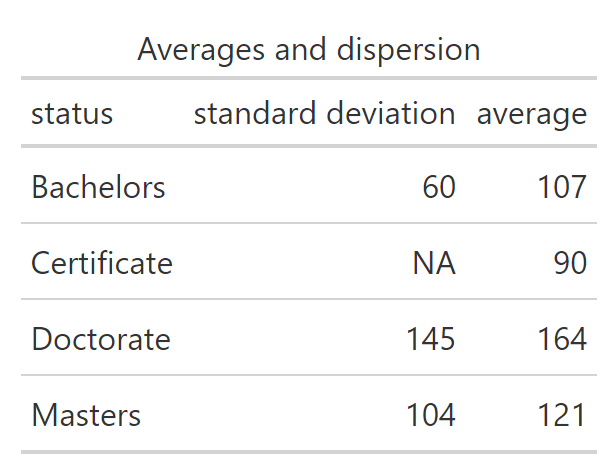
The number of applicants to jobs at doctoral institutions was higher on average than any other, but there was a lot more spread around that average. This is clear from the table, but also look at the following plots. Differences among numbers of applicants to BA-granting institutions are roughly linear. But for PhD-granting institutions, it’s closer to exponential. (There were relatively few MA-granting institution responses, so I’m hesitant to draw conclusions.)
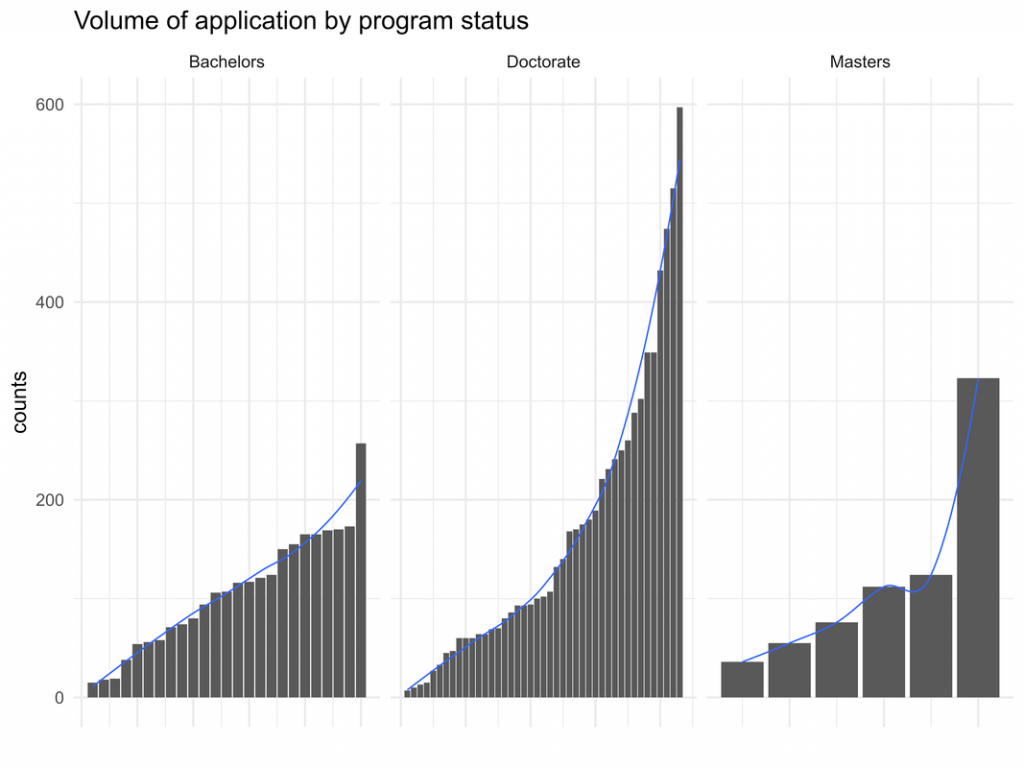
Now let’s pull together a bunch of info about applications to various programs: the fewest, average, median, and greatest number of applicants by program status.
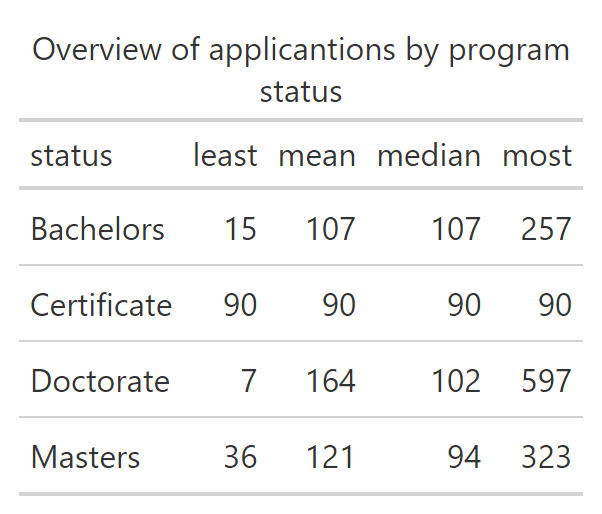
It looks like jobs with PhD programs are getting a lot more applications than any other. In fact, the values for max and average applications decreases as the status of the program goes from PhD to MA to BA. (It’s hard to draw conclusions about jobs at certificate-granting institutions since there was only one response.) A first hypothesis: Applicants preferentially apply for jobs at PhD-granting institutions. Two things to check: (i) whether the trend holds for R1 and R2 and (ii) if the values are a result of open-rank hires.
For (i), the trend doesn’t hold for differences between R1 and R2 jobs among respondents, but it’s worth noting that there were relatively few R2 respondents.
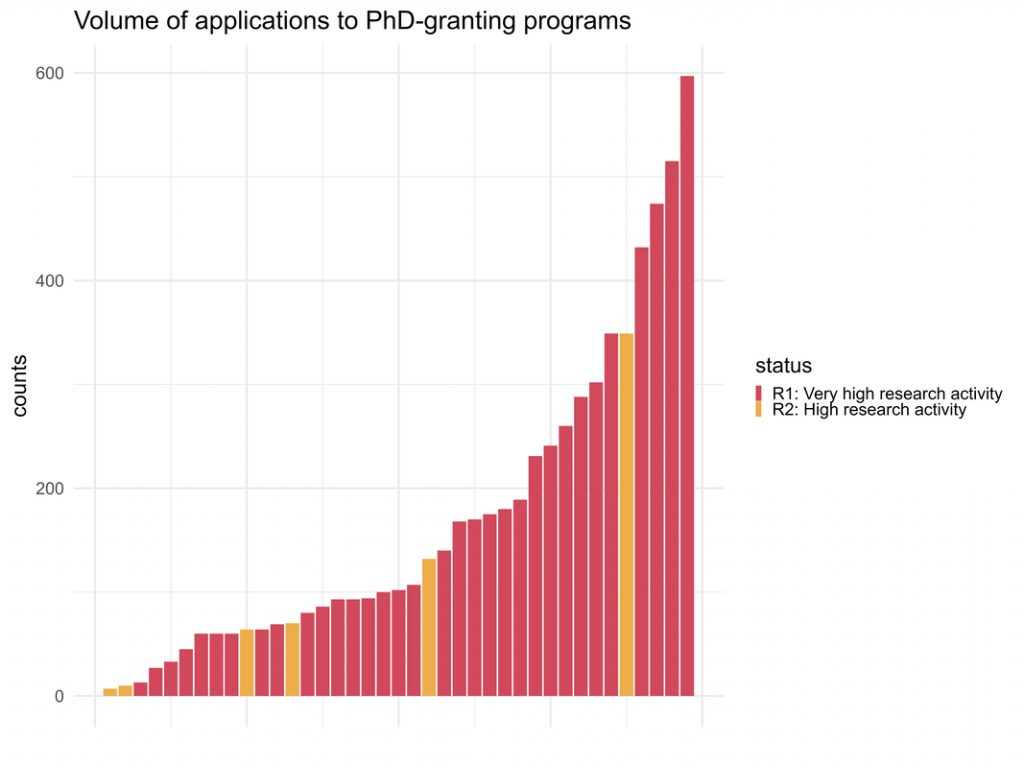
For (ii), let’s restrict the data to TT jobs only. That way, our numbers aren’t inflated by open-rank hires.
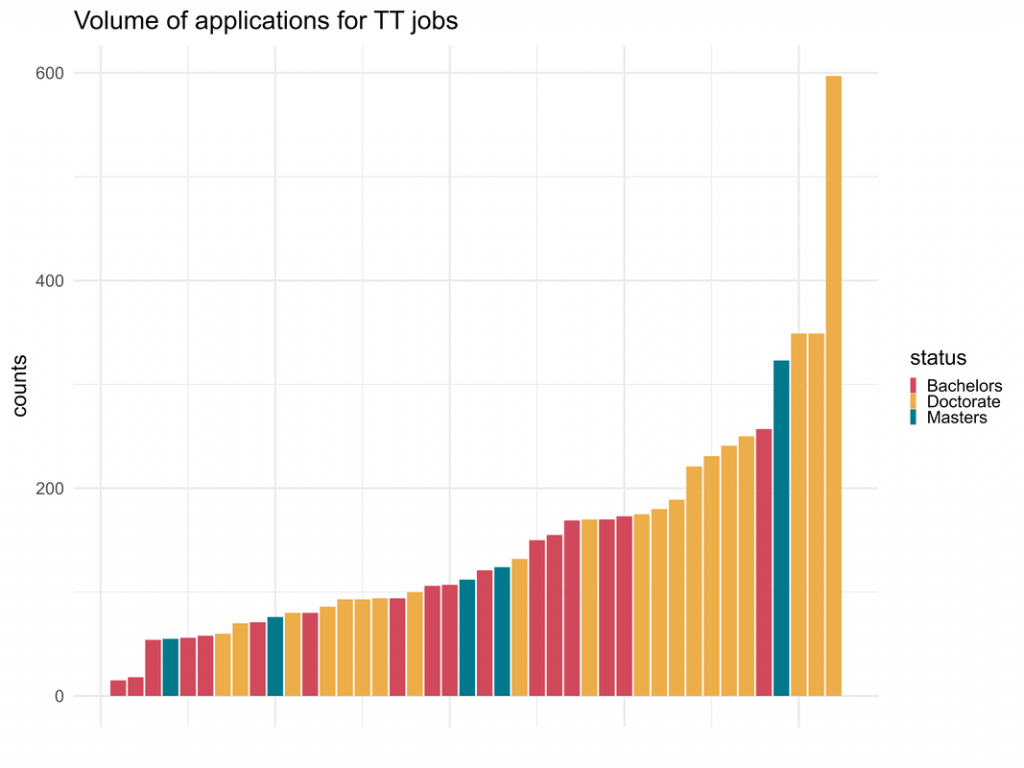
I think our initial hypothesis is right: applicants are biased towards applying for jobs at PhD-granting programs but the data don’t suggest that this bias holds for R1 vs R2 programs.
Let’s look at the numbers breaking out by AOS and program status. An important caveat: our 9% margin of error was for all responses to all surveys sent out. Once we begin dividing up the pool of responses, the margin of error increases and sometimes substantially. Suppose that the split between jobs advertised for BA- and PhD-granting institutions was 50/50. The MoE for the BA-granting average jumps to 17% and for the PhD-granting average to 12%. So once we begin parsing into subgroups, I’m saying less about all jobs for this year and more about the responses. I’ll try to be explicit about that where appropriate.
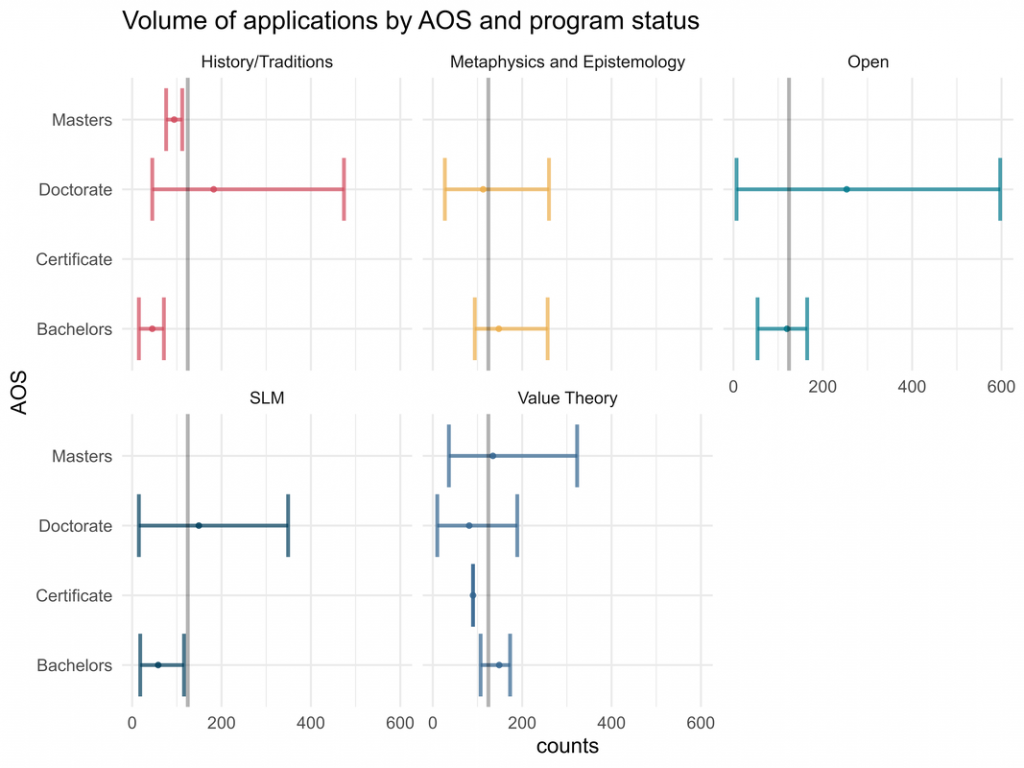
Here’s how to interpret the plot. The vertical grey line is the average for each AOS. The error bars give the minimum and maximum values for each status and AOS. The point in the error bar is the average for AOS and status. The tables for these values are here.
This plot pulls together a lot of what we’ve previously mentioned. Jobs at PhD-granting institutions tend to get more applications than elsewhere, particularly for open and history/tradition AOS. The jobs that on average had the fewest applications among respondents were history/tradition jobs at BA-granting institutions. In fact, in 2 out of 5 cases, the max number of applications for BA programs is less than the average for that AOS.
My interpretation of PhD-programs having more applicants is a manifestation of two sides of prestige bias. On one side, it’s plausible that many candidates want to apply almost exclusively to prestigious jobs, where being a PhD-granting program tracks prestige. The other side of the coin is that candidates sell themselves short, thinking that there’s no way they could make it past the first round at an R1 or R2.
That being said, if there are other plausible interpretations, please feel free to share!
One of the takeaways restricted to the respondents (but is perhaps indicative of the wider field of applicants and openings) is that if you’re applying to R1’s, you’ll likely find yourself with a lot more competition relative to MA- and BA-granting programs, particularly for open, science/language/math, and history/tradition AOS’s.
Two more tables before calling it a day: one about impressions of applicant volume and another about time allotment for the job.

So that’s good to know: typically, committee chairs have decent expectations for the numbers of applicants. How does this compare to the numbers of applications received?
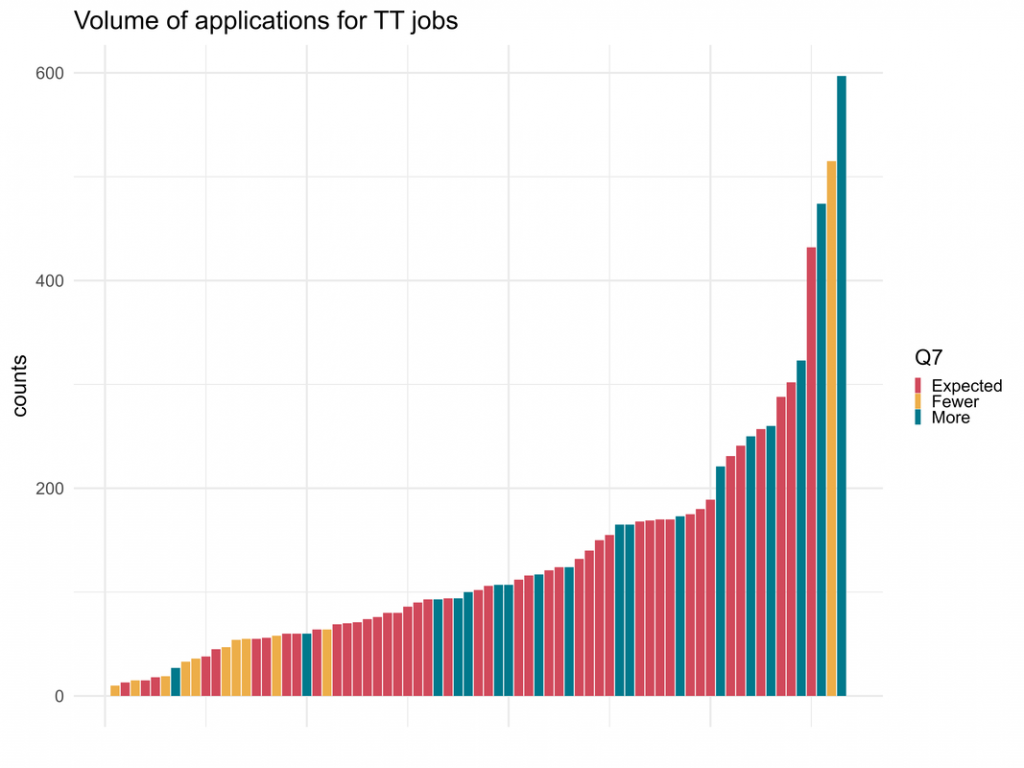
The “fewer” bar all the way to the right? That’s 515 applications for an open AOS, open rank position at an R1. With those parameters, I’d have guessed there would be more too.
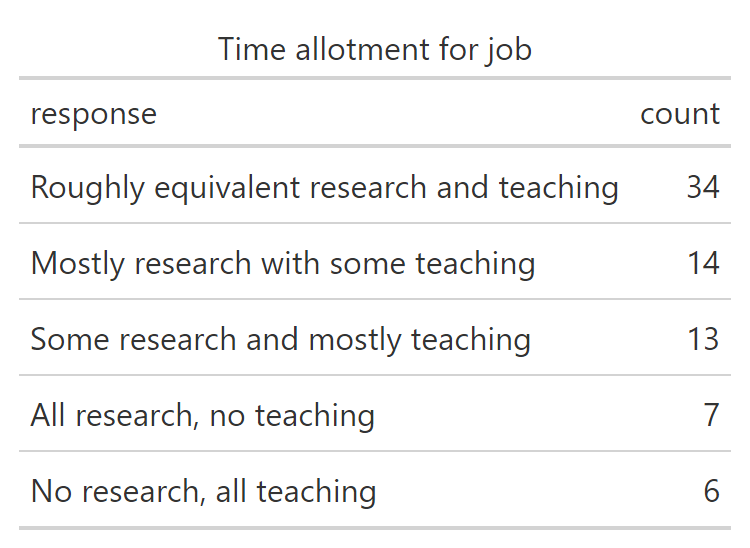
That’s useful to know: the typical response is that time spent teaching and researching is roughly equivalent. The breakdown for that number is:
BA-granting institutions: 8
MA-granting institutions: 4
PhD-granting institutions: 22
…which I found pretty darned interesting. As you might imagine, “mostly research with some teaching,” was largely PhD-granting institutions (12) and “some research and mostly teaching” was largely BA-granting institutions (10). The lesson, I think, is that job applicants can’t afford to neglect teaching or research in their applications but have to discern which to amplify for the job applied to. I think that’s common sense, but it’s nice to have some info to support it.
If you’d like the raw data and script, you can find them under the “blog data” tab.
Well, that’s all. If there are any other analyses you’d like to see, please let me know!


Sorry to ask a novice question, but what does R1/R2 mean?
https://carnegieclassifications.acenet.edu/carnegie-classification/research-designations-faqs/
“Applicants preferentially apply for jobs at PhD-granting institutions” makes it sound like some applicants are just snobs. However, some people who already have permanent jobs at undergraduate-only institutions will apply to PhD-granting departments (and not to BA-only ones) because they are looking to move up. The raw number of applicants doesn’t sort the people looking for any job from those looking for a better one.
Also, we need to know how many jobs there are at each type of school. Indeed, there may be many BA-only colleges, but there philosophy departments often have 5 or fewer people (hence, few jobs) whereas a PhD school will have 15-25 faculty (hence, relatively more jobs, per school)
Thanks for that. So the question you’re getting at is how many jobs are there in total for BA-granting vs PhD-granting. (It doesn’t matter if PhD-granting depts have more philosophers per dept relative to BA-granting depts if there are many more BA-granting depts relative to PhD-granting depts hiring in a given year.) I haven’t done the analysis on openings for BA-granting vs PhD-granting institutions. My intuition is based on the mean values, which mitigates concerns about the difference between absolute values of PhD-openings vs BA-openings.
Thanks. I disagree with the implicature of the initial claim, but that’s neither here nor there. I agree that the raw numbers don’t distinguish between those with jobs trying to “move up,” but I’m not sure how that’s relevant. Even if every applicant for every job were already gainfully employed, it wouldn’t change the fact that there were more applicants for PhD-granting institutions than BA-granting ones. Maybe I’m missing the core of the concern?
Yeah, I think P.D. is just identifying a hole in the data that really helps us understand what’s going on. The key concern, I think, is that the proportion of PhD-holders to philosophy job openings is getting smaller and smaller, but if, say, a lot of applications are people trying moving up, then that should change what we think of the proportion of PhD-holders to philosophy jobs is as compared to if almost none of the applications are people trying to move up. It’s a reason for tempering one’s potential doomer-ism.
The idea that it manifests snobbery comes in more explicitly when you later say “it’s plausible that many candidates want to apply almost exclusively to prestigious jobs, where being a PhD-granting program tracks prestige.” That could be true, but it also could be true that such people know that those jobs pay better (which isn’t itself prestige related; it’s widely known that many smaller institutions pay very poorly, and surely many applicants to PhD-granting jobs are coming from people trying to ‘move up’). Another question I had (related to P.D. Magnus’ point) was that it seems like you’re sometimes drawing the wrong generalization from your limited data. You say things like: “So the average for number of people on the market is probably somewhere between 125 and 147.” I don’t see how we can infer that. When we know that hundreds and perhaps even thousands of people are applying for at least 1 job, and that some jobs get 400-600 applicants, it’s very misleading to say that the “average” number of people “on the market” is less than 150. (I don’t even understand what this average claim is supposed to refer to… average across what class? It might be the avg. per job, but that’s very different from the avg. number of people applying for a job (or multiple jobs) in a given job cycle.)
I’m not fussed about the snobbery charge, but I can think of at least 4 other reasons why early career job seekers would preferentially apply at PhD-granting programs, independent of prestige.
Thanks for putting this together, it’s very interesting.
It’s probably not feasible to get the data necessary to tease apart the various causes for the substantially larger number of applications at PhD granting institutions. Given our experience at CMU, I have a few hypotheses:
#2 should be testable given the data you have. Is there a correlation between “level” of a job and whether it’s an open AOS?
#3 would be testable if one could get the data, but it would be difficult to generate and also possibly face privacy concerns.
Thanks for the comments, and I appreciate you sharing your experience at CMU.
Does this data distinguish between PhD granting institutions vs. PhD granting departments? E.g., one might teach at an R1 or R2 where the highest degree offered is a BA. I couldn’t tell if this distinction gets captured.
I’m sorry: this wasn’t clear. I meant an R1 or R2 where the highest philosophy degree offered is a BA.
Sorry for the confusion. I was switching between “institutions” and “departments” as a matter of style. Repeating one or the other was tedious (for me) to read.
Thanks for the reply: my concern is that this isn’t merely a stylistic difference, which was why I wasn’t sure how to interpret your conclusions. It looked like you asked about Carnegie Classification, but that’s separate from whether a university’s philosophy program offers PhDs. Many R1 universities, e.g., don’t offer doctoral degrees in philosophy.
So, e.g., when you write, “It looks like jobs with PhD programs are getting a lot more applications than any other” that could mean either “jobs at R1 and R2 universities get more applicants” or “jobs in PhD granting departments get more applicants” and those are two very different claims.
I’m sorry if I’ve misunderstood something about the questionnaire.
It would be interesting to know how many such differences there are!
It looks like there are something like 400 institutions that grant PhDs in the United States, and I believe there are a bit more than 100 institutions that grant PhDs in philosophy, so there must be a few hundred here.
https://ncses.nsf.gov/pubs/nsf24300/technical-notes
But that survey says that several institutions claimed to grant PhDs but listed 0 PhDs granted during the study period, so we might not want to count them. And I suspect that some others are like Rockefeller University and UCSF and Oregon Health Sciences University, where they don’t hire anyone outside the life sciences, so they wouldn’t show up in philosophy department hiring.
I’d be interested to see the ad for the job at a PhD-granting institution that only received 7 applications. I’d imagine it was a very narrow AOS.